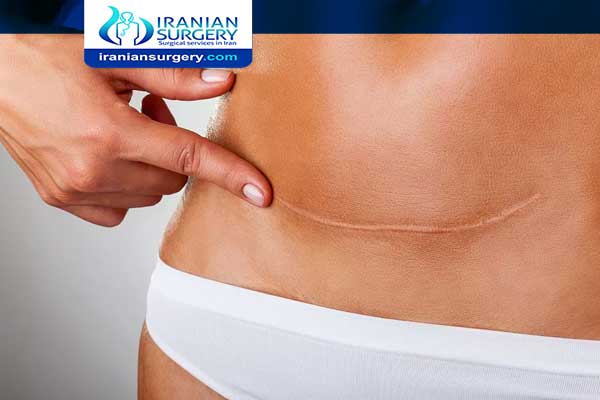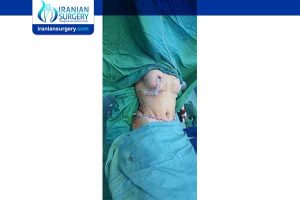Tummy tuck scar

Tummy Tuck ( abdominoplasty )offers a glorious promise: after just one procedure, patients can have a youthfully slim, firm, and flat abdominal contour. However, while this pledge is genuine, recapturing this figure is not an easy task, nor without sacrifice. In addition to the time required for recovery, patients will have to trade in their abdominal flab, stubborn fat, sagging skin, and stretch marks for a permanent horizontal scar. This scar, is an inevitable part of tummy tuck surgery, and the scars will never go away completely. They generally fade, however, and there are things you can do to help.

Read more about : How to hide blepharoplasty scars?
Read more about : Abdominoplasty Podcast with Dr. Afshan shah
Read more about : How much does tummy tuck surgery cost?
Read more about : The German patient saved $ 14,000 by choosing Iran over Germany to have stomach liposuction and abdominoplasty surgery.
Types of scars
Depending on the technique(s) used, incisions made, and individual healing factors, tummy tuck scars in several areas—including the pelvic region, around the belly button, and in the lower abdominal area—may be visible.
. Pelvic region
Regardless of the type of tummy tuck you have (full, mini, etc.), you will be left with a scar running horizontally across the lower abdomen between the hips, a couple of inches beneath the belly button. The length of the scar varies from a couple of inches to the entire length of the abdomen, sometimes extending up and over the hips to the back.
. Around the belly button
Some tummy tuck procedures produce a scar around the belly button. This scar will be visible at first but will often fade over time and eventually become unnoticeable. This is not always the case, though, as some scars remain visible even when fully healed.
. Lower abdomen
Certain patients require an incision extending down from the belly button to the horizontal incision.
“If someone has a lot of excess skin, it may not be enough to simply limit the scar to a horizontal scar that runs from hip to hip. In such cases, a person needs a fleur-de-lis scar, in which there is also a vertical component—usually in the midline—to tighten the skin in the Y-axis in addition to the X-axis.”
. Irregular scarring
Although it is rare, some individuals have a tendency to produce irregular scars.
The two most common are hypertrophic and keloid scars, Hypertrophic scars are raised and redder than the affected tissue. Keloid scars form beyond the original wound site. Both scars are due to an excess of collagen.
Different procedure, different scar
The type of scar(s) you end up with after your tummy tuck will depend on the type of tummy tuck you have. This is because different abdominoplasty techniques involve different incisions, and therefore produce different scars.
. Full tummy tuck
A full tummy tuck involves a long scar extending from hip to hip, possibly including the vertical fleur-de-lis component and a scar around the belly button.
. Mini tummy tuck
Many patients are under the false impression that a mini tummy tuck always involves a small incision, but this is generally not the case, the amount of skin removed will dictate how long the scars need to be, and the only big difference is the absence of an umbilical scar with the mini-tummy tuck. However, the procedure does not produce a scar around the belly button.
. Extended or High Lateral Tension Tummy Tuck
For an extended tummy tuck, the horizontal incision can stretch across the lower belly and around the hips, so when the body is viewed posteriorly the tail ends of the scar are visible and a vertical incision may also be required. This allows the surgeon to treat a wider area and remove more surplus tissue.

Read more about : Fever after tummy tuck
Read more about : Tummy tuck in Iran
Tummy Tuck scars over time
How long will the scar be after a Tummy Tuck procedure?
Scarring can vary significantly from patient to patient based primarily on individual healing abilities. Here is a generalized guideline of what tummy tuck scars may look like at various points:
. Tummy tuck scars after surgery: The scar is generally thin and pink. The body immediately triggers a healing response to close the incision over the next few weeks.
. Tummy tuck scars after one month: With the scar now closed, the increased collagen and blood supply have made the scar darker, thicker, and more noticeable. The appearance of the scar may worsen over the next few months.
Tummy tuck scars after six months: The scar may still be red and raised, but should begin to lighten soon if it has not done so already. Some of the excess collagen will begin to break down, and the increased blood supply will diminish. As a result, the scar will slowly flatten and lighten.
. Tummy tuck scars after one year: The scar may be fully mature and will be noticeably flatter, thinner, lighter, and less noticeable. It will continue to fade.
. Tummy tuck scars after five years: The mature scar will have faded noticeably and may continue to fade somewhat over time.
Like all surgical scars, abdominoplasty scars will never go away completely, but most patients feel they are well worth the benefits of achieving the smooth and flat abdominal contour they desire. Our doctors place the incisions as discreetly as possible to minimize scarring so that you can enjoy the best results. Most tummy tuck scars are easily hidden under panties and swimsuits.
Minimize scarring, speed healing and fading
Some level of scarring from tummy tuck is unavoidable. There is no way to avoid a scar once a full-thickness incision has been made. This is how our skin heals, If our bodies didn’t form scars, we all would be walking around with wounds still open from childhood.”
However, there are steps you and your surgeon can take to reduce scarring and speed the healing and fading process:
. Follow the care instructions from the surgeon
. Monitor the incision for infection
. Start a scar cream and/or silicone scar treatment once the incision no longer has any scabs (but don’t pick the scabs)
. Keep your skin well moisturized
. Don’t suntan your scars
. Avoid irritating products and clothing
Silicone scar treatment is the single most helpful thing you can do to reduce scarring, or at least its appearance.
Various topicals have been shown to be effective for optimizing the long-term appearance of scars.
There are also steps your surgeon can take:
The surgeon can use multiple layers of suture closure to take tension off the wound so that it does not stretch. In addition, the surgeon can use monofilament suture that is less irritating to the tissues. Finally, the surgeon can use devices such as the Prevena Incision Management System to completely take tension off the wound and prevent infection.
To help reduce overall skin tension, our doctor performs a layered complex closure of the incision line. He also uses topical scar-optimizing compounds immediately after surgery and up to the six-month mark.
We also encourage patients to undergo a series of microneedling /PRP treatments to their scars beginning about four–six weeks after their surgery. Studies have shown dramatic improvement in the appearance of not only acute but also chronic scarring when this protocol has been utilized.
Ultimately, the formation and appearance of your tummy tuck scars will depend on multiple factors, from genetics to actions taken by both you and your surgeon.
Scars can heal more quickly with a healthy diet and lifestyle, and when there is no tension or infection on the wound. But at the end of the day, the only thing that allows a scar to heal is the tincture of time.

Read more about : How to massage lumps after liposuction?
Read more about : Does fat transfer work for breast augmentation?
Read more about : Liposuction results week by week
Read more about : Maximum weight for liposuction
Read more about : How to get rid of fluid after liposuction?
Read more about : Does liposuction hurt?
Read more about : Lipomatic
At Home Scar Creams
If you want to do everything that you can to minimize scarring after a tummy tuck, heed all of your surgeon’s post-surgery recovery advice and carefully monitor your healing process.
Once the first stage of the recovery is over and the incision is free of scabs, it’s a good time to start an at-home treatment to further reduce scarring. Silicone-based scar treatments are among your best options for at-home treatment. If you are allergic to silicone or would like to tackle your scarring issue with a number of products, several non-silicone alternatives can also help.
While these options can’t get rid of a scar completely, they can make the appearance of scars much less noticeable.
Read more about : Revision tummy tuck
Read more about : Vaser liposuction
Read more about : what causes rippling after liposuction?
Read more about : Nerve pain after liposuction
Read more about : Bbl in Iran
Read more about : Liposuction in Iran
Read more about : Fever after tummy tuck
Read more about : Pain after liposuction flanks
Read more about : Lipomatic vs liposuction
Read more about : Can i drink alcohol after liposuction?

